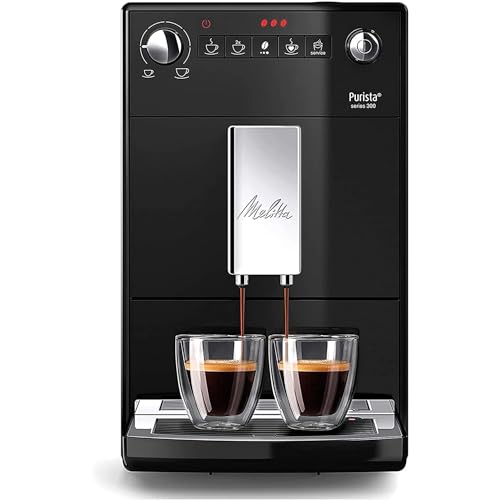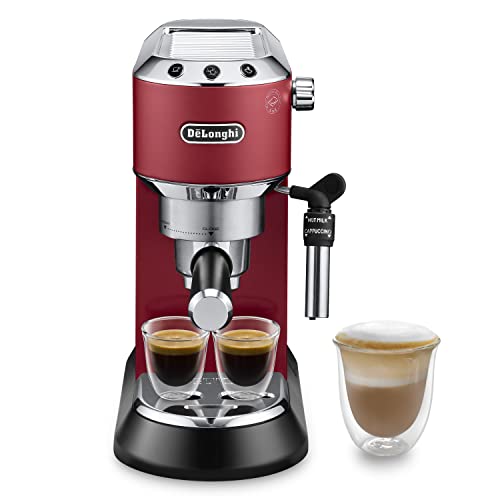Ten Easy Steps To Launch Your Own Espresso Machine Coffee Business
페이지 정보
작성자 … 작성일 24-11-17 06:22 조회 7 댓글 0본문
How to Make Espresso Machine Coffee
 Espresso machines can create an amazing cup of coffee, however they require more maintenance and setup than a standard coffee maker. It also requires you to grind and tamp your own beans.
Espresso machines can create an amazing cup of coffee, however they require more maintenance and setup than a standard coffee maker. It also requires you to grind and tamp your own beans.
Pressure is a key element in making espresso. What happens in an espresso machine is that a heating vessel heats the water to the ideal temperature, and then pushes it out from the spouts into the grounds.
Temperature
Espresso is created by forcing hot water under pressure through finely ground coffee beans. The temperature of the water is essential to the final shot. Low temperatures lead to a absence of flavor compounds. The high temperatures can cause over extraction, which may cause bitter or burned taste.
The ideal temperature for espresso is between 195 and 205degF. This temperature can be achieved by using a grouphead designed to maintain a constant temperature and stability throughout the brewing process. The E61 is the most well-known group head, as it offers a combination of the ability to stabilize temperature, pre-infusion and lever control.
When altering the espresso machine for different roasts and brew ratios, it is crucial to take into consideration the effect of temperature on extraction yield as well as crema. The ideal temperature will vary on the particular roast and beans but the general rule is that lighter roasts and greater ratios of brews require higher temperatures than dark roasts and lower brew ratios. A high end espresso machine-quality thermocouple is crucial to keep the temperature at a constant level.
Pressure
During the brewing process, espresso machine coffee is pressure-pushed through finely ground and tamped grounds. This creates chemical reactions that extract flavors oils, flavors and other soluble ingredients from the beans. The resulting drink is usually richer and more flavorful than regular coffee.
The ideal espresso machine's pressure should be nine bars equivalent to atmospheric pressure at sea-level. The soluble components in the espresso bean are best extracted at this pressure.
Some espresso machines advertise up to 20 bars of pressure. These machines might be able to reach these pressure levels, however, they might not be able to maintain them throughout the extraction.
To put it into perspective To put it in perspective, one bar of pressure equals 32 pounds per square inch PSI of the tire of a car. It's nearly four times the pressure a professional espresso machine for home (Related Homepag) cyclist applies to their bike tires. Any serious home barista has to be able to regulate the pressure of their espresso machine, and also produce consistent espressos.
Water
Water is a key ingredient to a perfect cup of espresso maker barista. The right water helps your beans reach their maximum potential. However the wrong water can cause problems such as clogged pipes and even damage your expensive machine.
The best choice is a natural spring water that is rich in minerals that will ensure the best espresso extraction. This water will enhance the taste of your brew without the chalky mineral traces that come from tap or bottled water. This is an excellent alternative to reverse osmosis. This process can be too purified and cause problems with flavor.
But, you shouldn't use water filters that remove too many minerals from the tap water, because this can lead to extraction and flavor issues. A good solution is to purchase an instrument for testing water, which will reveal the local average hardness. This information can be used in determining the ideal filtration system for your espresso machine.
Beans
The majority of coffee enthusiasts tend to be very involved in the process of making espresso. They get obsessed about a range of factors, including temperature, water pressure and viscosity. If one of these variables is slightly off, the whole shot might taste bad.
The most important element when it comes to espresso is the beans used. Many people believe that certain kinds are suitable for espresso. While certain beans are suitable for certain uses but any coffee bean can be used to make espresso. The main difference between espresso beans and regular coffee beans is that espresso beans are roasted longer, tipycally past the second crack that gives them an appearance darker and makes them more soluble in water.
The best beans for espresso are usually medium-roasted or dark roasted, which give the shots that distinctive richness and vigor. However, it is possible to make excellent espresso with light roasted beans, especially when these beans are preground (for convenience in the espresso machine).
Milk
decent espresso machine and milk are a timeless combination. Not only does the coffee increase energy levels, but the steaming milk helps to offset the bitterness of the espresso and also adds a wonderful creaminess. This is one of the best culinary pairings!
When you are choosing an espresso machine capable of making latte or the cappuccino as well it is important to consider how easy it is to use. Many of the best machines come with a jug for hot or cold milk, as well as steam wand. They also have a portafilter for pulling the shot. Some models come with an inbuilt grinder, tamper, or frother.
To eliminate any condensed water the steam wand has to be cleaned every day prior to use (or after each espresso cup). The process takes only 30 seconds, but it's vital to ensure that your machine stays running smoothly. Failure to cleanse could cause a bitter taste or build-up of bacteria that can affect the flavor and smell of your beverages. It's not difficult to do and should be part of your routine maintenance routine.
 Espresso machines can create an amazing cup of coffee, however they require more maintenance and setup than a standard coffee maker. It also requires you to grind and tamp your own beans.
Espresso machines can create an amazing cup of coffee, however they require more maintenance and setup than a standard coffee maker. It also requires you to grind and tamp your own beans.Pressure is a key element in making espresso. What happens in an espresso machine is that a heating vessel heats the water to the ideal temperature, and then pushes it out from the spouts into the grounds.
Temperature
Espresso is created by forcing hot water under pressure through finely ground coffee beans. The temperature of the water is essential to the final shot. Low temperatures lead to a absence of flavor compounds. The high temperatures can cause over extraction, which may cause bitter or burned taste.
The ideal temperature for espresso is between 195 and 205degF. This temperature can be achieved by using a grouphead designed to maintain a constant temperature and stability throughout the brewing process. The E61 is the most well-known group head, as it offers a combination of the ability to stabilize temperature, pre-infusion and lever control.
When altering the espresso machine for different roasts and brew ratios, it is crucial to take into consideration the effect of temperature on extraction yield as well as crema. The ideal temperature will vary on the particular roast and beans but the general rule is that lighter roasts and greater ratios of brews require higher temperatures than dark roasts and lower brew ratios. A high end espresso machine-quality thermocouple is crucial to keep the temperature at a constant level.
Pressure
During the brewing process, espresso machine coffee is pressure-pushed through finely ground and tamped grounds. This creates chemical reactions that extract flavors oils, flavors and other soluble ingredients from the beans. The resulting drink is usually richer and more flavorful than regular coffee.
The ideal espresso machine's pressure should be nine bars equivalent to atmospheric pressure at sea-level. The soluble components in the espresso bean are best extracted at this pressure.
Some espresso machines advertise up to 20 bars of pressure. These machines might be able to reach these pressure levels, however, they might not be able to maintain them throughout the extraction.
To put it into perspective To put it in perspective, one bar of pressure equals 32 pounds per square inch PSI of the tire of a car. It's nearly four times the pressure a professional espresso machine for home (Related Homepag) cyclist applies to their bike tires. Any serious home barista has to be able to regulate the pressure of their espresso machine, and also produce consistent espressos.
Water
Water is a key ingredient to a perfect cup of espresso maker barista. The right water helps your beans reach their maximum potential. However the wrong water can cause problems such as clogged pipes and even damage your expensive machine.
The best choice is a natural spring water that is rich in minerals that will ensure the best espresso extraction. This water will enhance the taste of your brew without the chalky mineral traces that come from tap or bottled water. This is an excellent alternative to reverse osmosis. This process can be too purified and cause problems with flavor.
But, you shouldn't use water filters that remove too many minerals from the tap water, because this can lead to extraction and flavor issues. A good solution is to purchase an instrument for testing water, which will reveal the local average hardness. This information can be used in determining the ideal filtration system for your espresso machine.
Beans
The majority of coffee enthusiasts tend to be very involved in the process of making espresso. They get obsessed about a range of factors, including temperature, water pressure and viscosity. If one of these variables is slightly off, the whole shot might taste bad.
The most important element when it comes to espresso is the beans used. Many people believe that certain kinds are suitable for espresso. While certain beans are suitable for certain uses but any coffee bean can be used to make espresso. The main difference between espresso beans and regular coffee beans is that espresso beans are roasted longer, tipycally past the second crack that gives them an appearance darker and makes them more soluble in water.
The best beans for espresso are usually medium-roasted or dark roasted, which give the shots that distinctive richness and vigor. However, it is possible to make excellent espresso with light roasted beans, especially when these beans are preground (for convenience in the espresso machine).
Milk
decent espresso machine and milk are a timeless combination. Not only does the coffee increase energy levels, but the steaming milk helps to offset the bitterness of the espresso and also adds a wonderful creaminess. This is one of the best culinary pairings!
When you are choosing an espresso machine capable of making latte or the cappuccino as well it is important to consider how easy it is to use. Many of the best machines come with a jug for hot or cold milk, as well as steam wand. They also have a portafilter for pulling the shot. Some models come with an inbuilt grinder, tamper, or frother.
To eliminate any condensed water the steam wand has to be cleaned every day prior to use (or after each espresso cup). The process takes only 30 seconds, but it's vital to ensure that your machine stays running smoothly. Failure to cleanse could cause a bitter taste or build-up of bacteria that can affect the flavor and smell of your beverages. It's not difficult to do and should be part of your routine maintenance routine.

댓글목록 0
등록된 댓글이 없습니다.